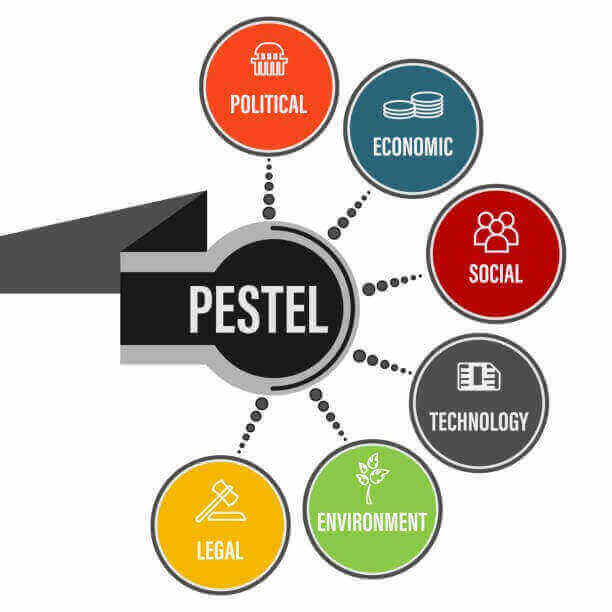The PESTEL model is a strategic framework used in marketing and business analysis to assess the external macro-environmental factors that can impact a company or industry. It stands for Political, Economic, Social, Technological, Environmental, and Legal factors.
1. Political Factors: Political factors encompass the influence of government policies, regulations, and political stability on businesses. This includes taxation policies, trade regulations, labor laws, government stability, and political ideologies. Political decisions can significantly impact industries and companies, shaping their operations and strategies.
2. Economic Factors: Economic factors pertain to a country’s or region’s economic conditions and how they impact businesses. Key considerations include economic growth rates, inflation rates, exchange rates, interest rates, and overall economic stability. These factors influence consumer spending patterns, business investments, and market demand.
3. Social Factors: Social factors reflect the cultural, demographic, and societal trends that affect consumer behavior and preferences. These include population demographics, social norms, lifestyle changes, education levels, and cultural values. Businesses need to adapt to these shifts to meet consumer needs and expectations.
4. Technological Factors: Technological factors refer to advancements and innovations in technology that can impact industries and businesses. This includes automation, digitalization, research and development, new product developments, and technological infrastructure. Technological factors can lead to new opportunities and disruptions in various sectors.
5. Environmental Factors: Environmental factors highlight the impact of ecological and environmental considerations on businesses. This includes climate change, sustainability practices, environmental regulations, resource availability, and consumer demand for eco-friendly products. Businesses need to consider their environmental footprint and adopt sustainable practices.
6. Legal Factors: Legal factors encompass the legal and regulatory environment within which businesses operate. This includes labor, health and safety laws, intellectual property, consumer protection, and industry-specific regulations. Adhering to legal requirements is crucial for avoiding legal issues and maintaining business ethics.

Let’s explore its relevance in today’s business world and why it’s used for competition analysis, using examples from different industries:
Relevance in Today’s Business World:
In the modern business landscape, where factors such as globalization, rapid technological advancements, and shifting consumer preferences play a significant role, the PESTEL model remains highly relevant. It helps businesses navigate complexities by examining the external forces that shape markets and industries, aiding in strategic decision-making and adapting to change.
Importance for Competition Analysis:
The PESTEL model is crucial for competition analysis because it provides a comprehensive view of the external environment in which companies operate. By understanding these factors, businesses can anticipate challenges, seize opportunities, and develop strategies that give them a competitive edge.
PESTEL Framework with Examples of Different Industry
1. Retail Industry:
– Political: Government policies on taxation trade agreements affecting imports and exports.
– Economic: Consumer spending patterns and inflation rates influence pricing strategies.
– Social: Changing consumer lifestyles and preferences for sustainable products.
– Technological: E-commerce growth, mobile shopping apps.
– Environmental: Demand for eco-friendly packaging sustainability initiatives.
– Legal: Consumer protection laws and regulations on product labelling.
2. Healthcare Industry:
– Political: Healthcare policies and regulations on pharmaceutical pricing.
– Economic: Healthcare expenditure, reimbursement systems for medical procedures.
– Social: Aging population, increasing focus on preventive care.
– Technological: Telemedicine advancements, electronic health records.
– Environmental: Waste disposal regulations, green healthcare initiatives.
– Legal: Medical malpractice laws, patient data privacy regulations.
3. Tourism Industry:
– Political: Visa regulations and political stability affecting tourist safety.
– Economic: Exchange rates impacting international travel costs.
– Social: Travel trends influenced by social media and cultural preferences.
– Technological: Online booking platforms, travel apps.
– Environmental: Sustainable tourism practices, environmental impact of travel.
– Legal: Regulations on tourist accommodations, health and safety standards.
The PESTEL framework with examples provides insights into factors that can shape market dynamics, influence consumer behavior, and impact business strategies in each industry. By considering these external factors, companies can make informed decisions, identify opportunities, and address challenges to stay competitive and thrive in their respective industries.
Follow Nitin Kr Saxena
Professor of Marketing & an esteemed alumnus of IIM Ahmedabad, Dr. Saxena holds a Ph.D. in Brand Management, which garnered him the prestigious Best Ph.D. Thesis award. Recognized for his exceptional contributions to academia, Dr. Saxena has been honored with the Young Faculty by CEGR. Additionally, he received the “Best Professor in Marketing Analytics” award.